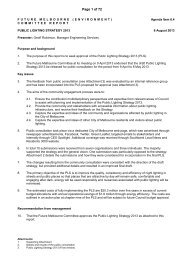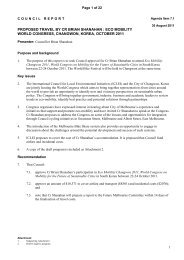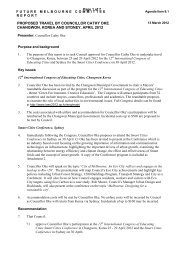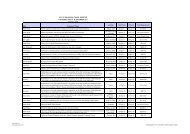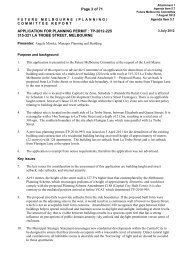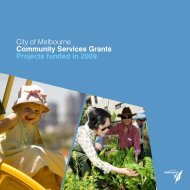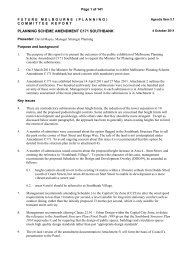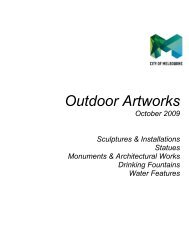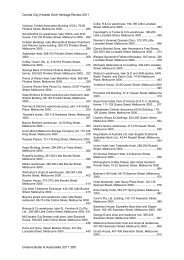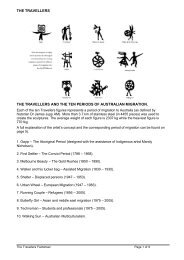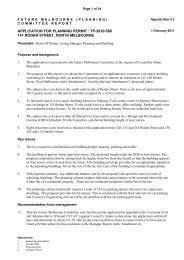A Guide to Food Hygiene - City of Melbourne
A Guide to Food Hygiene - City of Melbourne
A Guide to Food Hygiene - City of Melbourne
You also want an ePaper? Increase the reach of your titles
YUMPU automatically turns print PDFs into web optimized ePapers that Google loves.
A <strong>Guide</strong> <strong>to</strong> <strong>Food</strong> <strong>Hygiene</strong>
Contents<br />
Introduction 1<br />
Topic 1. <strong>Food</strong> Law and You 2<br />
What is food safety? 2<br />
Your responsibilities as a<br />
food handler 3<br />
<strong>Food</strong> poisoning 3<br />
Topic 2. <strong>Food</strong> <strong>Hygiene</strong><br />
– Keeping <strong>Food</strong> Safe 4<br />
<strong>Food</strong> safety hazards 4<br />
<strong>Food</strong> spoilage and food poisoning 4<br />
High risk foods 5<br />
Low risk foods 5<br />
The food poisoning chain 6<br />
What <strong>to</strong> do <strong>to</strong> prevent it<br />
The right conditions: time,<br />
6<br />
moisture, temperature 7<br />
Temperature moni<strong>to</strong>ring 8<br />
Cross contamination 9<br />
<strong>Food</strong> s<strong>to</strong>rage 10<br />
Thawing 12<br />
Cooking, cooling and reheating 13<br />
Bain-maries and pie warmers<br />
Ready-<strong>to</strong>-eat foods and ’no <strong>to</strong>uch’<br />
14<br />
techniques 14<br />
Topic 3. Personal <strong>Hygiene</strong> 15<br />
Clothing, nails, hair and jewellery<br />
Wash your hands - when, how<br />
15<br />
and what you need 16<br />
When you are sick 18<br />
Smoking<br />
Gloves - How <strong>to</strong> use and when<br />
18<br />
<strong>to</strong> change 18<br />
Topic 4. Cleaning 19<br />
Clean as you go 19<br />
What do I clean with? 19<br />
How do I clean? 20<br />
What is a cleaning schedule? 21<br />
Cleaning Schedule<br />
Pests - Common pests and<br />
21<br />
what they can do 22<br />
Garbage 22<br />
Good house keeping tips 23<br />
Solutions <strong>to</strong> Activities 24 & 25
Introduction<br />
Everyone who handles food in your business needs <strong>to</strong> know how <strong>to</strong> handle it safely.<br />
Before any person starts work as a food handler, they should have the right skills and<br />
knowledge in food safety and food hygiene. It is a legal requirement and part <strong>of</strong> the<br />
<strong>Food</strong> Safety Program for the business.<br />
This guide is designed <strong>to</strong> give food handlers a basic understanding <strong>of</strong> why hygiene is so<br />
important when handling food, how and why food poisoning occurs and what people who<br />
work with food can do <strong>to</strong> prevent it. The <strong>to</strong>pics cover:<br />
1. <strong>Food</strong> Law and You<br />
2. <strong>Food</strong> <strong>Hygiene</strong> - Keeping <strong>Food</strong> Safe<br />
3. Personal <strong>Hygiene</strong><br />
4. Cleaning<br />
Work through each <strong>to</strong>pic and along the way do the activities <strong>to</strong> test your knowledge.<br />
Solutions can be found at the back <strong>of</strong> this book.<br />
Once you have worked your way through the booklet, pass it on <strong>to</strong> another staff member or<br />
put it somewhere handy. It is a practical reference <strong>to</strong>ol that you can use when doing your job!<br />
Throughout this booklet our <strong>Food</strong> Safety Supervisor champion<br />
will provide you with handy tips and important information. Pay<br />
close attention <strong>to</strong> her advice as you work through each <strong>to</strong>pic.<br />
1
2<br />
Topic 1. <strong>Food</strong> Law and You<br />
What is food safety?<br />
<strong>Food</strong> safety is just common sense! It means keeping things clean and<br />
serving hot foods hot and cold foods cold.<br />
<strong>Food</strong> safety involves food s<strong>to</strong>rage, temperature control, cleaning and<br />
sanitising, personal hygiene, and pest control.<br />
If you work with food, YOU have an important responsibility <strong>to</strong> handle<br />
it safely.<br />
A <strong>Food</strong> Safety Program is the operating manual for the food business<br />
that you work in and a requirement under the <strong>Food</strong> Act 1984. You may<br />
be required <strong>to</strong> complete records that are part <strong>of</strong> the <strong>Food</strong> Safety Program.<br />
Your <strong>Food</strong> Safety Supervisor will be able <strong>to</strong> show you which records these<br />
are and how <strong>to</strong> fill them out.<br />
ACTIVITY - <strong>Food</strong> Safety Supervisor says…<br />
“Have a look at this car<strong>to</strong>on. Can you see any food safety problems?<br />
There are 20 problems in all <strong>to</strong> find”.
<strong>Food</strong> Safety Supervisor says …<br />
“As a food handler you have many tasks <strong>to</strong> do.<br />
If you are unsure <strong>of</strong> how <strong>to</strong> do them properly just<br />
come and check with me.”<br />
Your responsibilities as a food handler<br />
A food handler is anyone in the business who has anything <strong>to</strong> do with food or a surface that<br />
will come in<strong>to</strong> contact with food. You could be a food process worker, kitchen hand, a canteen<br />
worker, a waiting or serving staff member, a bakery assistant, a sandwich hand, or involved in<br />
clearing and cleaning tables.<br />
The <strong>Food</strong> Safety Supervisor in your workplace should be able <strong>to</strong> help you with anything that you<br />
are unsure <strong>of</strong>.<br />
Remember, as a food handler you need <strong>to</strong> handle and serve food safely. This is one <strong>of</strong> your key<br />
responsibilities. You can also be fined under the food law. In Vic<strong>to</strong>ria, food handlers must<br />
follow the <strong>Food</strong> Act 1984.<br />
<strong>Food</strong> poisoning<br />
Most us have experienced food poisoning or know<br />
someone who has. While symp<strong>to</strong>ms are similar <strong>to</strong> many<br />
s<strong>to</strong>mach ‘bugs’ – vomiting, diarrhoea, s<strong>to</strong>mach pains,<br />
aching joints and generally feeling unwell – some food<br />
poisonings can cause death, especially in children, the<br />
elderly and the very ill.<br />
<strong>Food</strong> poisoning is serious and also costly due <strong>to</strong> the<br />
following possibilities:<br />
• Cus<strong>to</strong>mers getting sick<br />
• Death in severe cases<br />
• Closure <strong>of</strong> the food premises<br />
• Loss <strong>of</strong> jobs<br />
• Bad publicity/loss <strong>of</strong> reputation by media/word <strong>of</strong><br />
mouth<br />
• Legal action taken by affected cus<strong>to</strong>mers<br />
3
4<br />
Topic 2. <strong>Food</strong> <strong>Hygiene</strong> – Keeping <strong>Food</strong> Safe<br />
<strong>Food</strong> hygiene is not only about cleanliness. It is also about taking the correct steps <strong>to</strong> make<br />
sure that the food that you handle and serve is safe.<br />
Good food hygiene practices means that you will have satisfied cus<strong>to</strong>mers, a safe and clean<br />
workplace, and meet your legal requirements.<br />
Bad food hygiene practices can lead <strong>to</strong> food contamination and outbreaks <strong>of</strong> food poisoning.<br />
<strong>Food</strong> safety hazards<br />
A food safety hazard is something found in food that shouldn’t be there. Hazards can be<br />
harmful once in the food. This is called contamination.<br />
There are three types <strong>of</strong> hazards that can contaminate food:<br />
Microbiological hazards - include bacteria, fungi, yeasts and moulds.<br />
Chemical hazards - food contaminated by cleaning chemicals or pesticides.<br />
Physical hazards - things found in food that are not meant <strong>to</strong> be there.<br />
Imagine finding some <strong>of</strong> these things in your food:<br />
• Hair, fingernails or band aids<br />
• Bolts, wire, nails or screws from machinery<br />
• Glass, wood chips or razor blades<br />
• Maggots, moths or flies<br />
<strong>Food</strong> Safety Supervisor says …<br />
“As a food handler you are responsible for serving safe food.<br />
Be aware <strong>of</strong> these food safety hazards!”<br />
<strong>Food</strong> spoilage and food poisoning<br />
<strong>Food</strong> spoilage is when food goes ‘<strong>of</strong>f’. Some examples include sour milk, mouldy bread, and<br />
vegetables that have gone green and slimy. The smell, taste and look <strong>of</strong> the food make it unfit <strong>to</strong><br />
eat and should be thrown away, however this is not food poisoning.<br />
<strong>Food</strong> poisoning is different <strong>to</strong> food spoilage because<br />
you can’t see or smell any difference in the food.<br />
The food looks, smells and tastes normal even though<br />
there are many food poisoning bacteria on the food.
High risk foods<br />
Bacteria need food <strong>to</strong> survive and there are certain types <strong>of</strong> food that food poisoning bacteria<br />
grow well in. These are grouped <strong>to</strong>gether and called high risk foods.<br />
These high risk foods are also called potentially hazardous foods. They are high in protein and<br />
water content (they are <strong>of</strong>ten moist) and include:<br />
• Eggs and egg products (such as cooked eggs in salad)<br />
• Rice (cooked or partially cooked) and pasta (cooked or fresh)<br />
• Beans (cooked or partially cooked) such as kidney,<br />
lima or borlotti beans<br />
• Raw and cooked meats<br />
• Fish and poultry<br />
• Stuffing for meat and poultry<br />
• Stews, soups and s<strong>to</strong>cks<br />
• Pizza, sandwiches and filled cakes<br />
• Milk and dairy products such as cream, cheese and custards<br />
• Sauces and gravies<br />
• Processed and canned meats (after opening)<br />
• Shellfish (especially oysters)<br />
Low risk foods<br />
Bacteria don’t grow well in these foods:<br />
Dry - Packaged foods such as flour, tea, c<strong>of</strong>fee, dry pasta, sugar and dried fruits are safe<br />
foods. These foods don’t need refrigeration and have a long shelf life. However many dried<br />
foods become high risk foods once water is added - for instance cooked rice or pasta.<br />
Frozen - No bacterial growth occurs in frozen foods as water is in solid form. Bacteria will grow<br />
once the food is defrosted.<br />
High in acid - pickles, chutneys, <strong>to</strong>ma<strong>to</strong>es<br />
High in salt and sugar - salty and sweet foods<br />
5
6<br />
The food poisoning chain<br />
A chain <strong>of</strong> events take place before food poisoning occurs:<br />
Source <strong>of</strong> food poisoning<br />
Transfer <strong>of</strong> bacteria<br />
Growth <strong>of</strong> bacteria (in the right conditions)<br />
<strong>Food</strong> is eaten<br />
FOOD POISONING<br />
• There must be food poisoning bacteria on the food<br />
• The bacteria must have the right conditions <strong>to</strong> multiply<br />
• The food must be eaten for food poisoning <strong>to</strong> occur<br />
What <strong>to</strong> do <strong>to</strong> prevent it<br />
There are three steps that can be<br />
taken <strong>to</strong> prevent food poisoning:<br />
Step 1 - protecting food from<br />
bacterial contamination with correct<br />
handling and s<strong>to</strong>rage.<br />
Step 2 - preventing the growth <strong>of</strong><br />
bacteria in food through time and<br />
temperature moni<strong>to</strong>ring.<br />
Step 3 - destroying or reducing<br />
bacteria present in food by cooking<br />
food thoroughly - this can be<br />
checked using a thermometer.
The right conditions: time, moisture, temperature<br />
Time<br />
Under the right conditions, bacteria can multiply every<br />
20 minutes. This means that in 3.5 hours, one bacterium<br />
can become one million bacteria.<br />
Moisture<br />
Bacteria need moisture <strong>to</strong> grow. If there is no moisture,<br />
the growth may slow down or s<strong>to</strong>p. This is why drying<br />
food is a safe way <strong>to</strong> preserve it.<br />
100<br />
90<br />
80<br />
70<br />
60<br />
50<br />
40<br />
30<br />
20<br />
10<br />
0<br />
Danger<br />
Zone<br />
Temperature<br />
Bacteria grow in temperatures between 5°C and 60°C.<br />
This temperature range is called the Danger Zone.<br />
At 5°C bacteria start growing. They grow faster as the<br />
temperature rises up <strong>to</strong> approximately 45°C when their<br />
growth slows.<br />
Bacteria s<strong>to</strong>p growing at around 60°C. <strong>Food</strong> must be cooked<br />
<strong>to</strong> reach a core temperature above 75°C <strong>to</strong> kill bacteria.<br />
<strong>Food</strong> in the freezer - Bacteria are not active when food is frozen<br />
solid (-18°C and below).<br />
<strong>Food</strong> in the refrigera<strong>to</strong>r - Temperatures (0-4°C) prevent most<br />
food poisoning bacteria from growing.<br />
<strong>Food</strong> at room temperature – <strong>Food</strong> is in the Danger Zone<br />
(5-60°C) which are ideal conditions for bacteria growth and<br />
reproduction.<br />
TAKE CARE: <strong>Food</strong>s are not <strong>to</strong> be in the danger zone<br />
(between 5°C and 60°C) longer than necessary.<br />
7
8<br />
Temperature moni<strong>to</strong>ring<br />
The temperature <strong>of</strong> food is taken using a probe thermometer. To take the temperature <strong>of</strong> foods<br />
you should:<br />
1. Wash the probe. Rinse the probe under hot running water before each use.<br />
2. Sanitise. Wash in sanitising solution or use sanitising wipes before each use.<br />
3. Insert. Put the probe in<strong>to</strong> food.<br />
4. Read and record. Write down the temperature on the <strong>Food</strong> Safety Program record form.<br />
Wash Sanitise Insert Read/record<br />
If you don’t think that the reading sounds right or the food is between 5°C and 60°C,<br />
check with your <strong>Food</strong> Safety Supervisor.<br />
<strong>Food</strong> Safety Supervisor says… “Remember always:<br />
• Take the core (internal) temperature by putting the probe<br />
in<strong>to</strong> the thickest part <strong>of</strong> the food<br />
• Stir liquids (such as soups and sauces) before taking temperature<br />
• Wash and sanitise the probe between every reading”
Cross contamination<br />
<strong>Food</strong> poisoning bacteria are all around us everyday. They can be found in the soil,<br />
on animals, on our skin and our things. In fact, everything that we <strong>to</strong>uch and use!<br />
Cross contamination is when bacteria contaminates food or a food contact surface.<br />
<strong>Food</strong> is usually cross contaminated by food handlers incorrectly handling food.<br />
Here are some dos and don’ts for when handling food:<br />
✓ Do<br />
✓ Keep raw meat and vegetables away<br />
from cooked food<br />
✓ Keep cooked meat above raw meat<br />
in the refrigera<strong>to</strong>r<br />
✓ Keep food covered <strong>to</strong> protect from dust,<br />
flies and dirt<br />
✓ Thoroughly rinse/wash all fruit and<br />
vegetables in clean water <strong>to</strong> remove soil,<br />
insects and chemicals<br />
✓ Clean and sanitise all equipment and<br />
benches<br />
✓ Keep food s<strong>to</strong>red in food-grade<br />
containers<br />
✓ Wear clean protective clothing<br />
✓ Wash hands before handling food<br />
✗ Don’t<br />
✗ Chop raw and cooked meat on the<br />
same chopping board<br />
✗ Handle raw food then cooked food<br />
without washing your hands<br />
✗ Use food handling gloves for handling<br />
money<br />
✗ S<strong>to</strong>re food uncovered in the fridge<br />
or cool room<br />
✗<br />
Remember, make hand washing and good personal and food<br />
hygiene habits a way <strong>of</strong> life.<br />
<strong>Food</strong> Safety Supervisor says…<br />
Did you know that it is really easy <strong>to</strong> cross contaminate food through:<br />
• <strong>Food</strong> handlers’ poor hygiene habits<br />
• Your suppliers<br />
•S<strong>to</strong>ring foods incorrectly<br />
9
10<br />
<strong>Food</strong> s<strong>to</strong>rage<br />
ACTIVITY - <strong>Food</strong> Safety Supervisor says…<br />
“Read Joe’s diary carefully and determine which tasks were<br />
performed correctly”. (Insert ✓or ✗)<br />
Sliced vegetables with a clean and sanitised knife<br />
Used the same knife <strong>to</strong> slice the cooked ham<br />
Washed <strong>to</strong>ma<strong>to</strong>es in the hand-wash basin<br />
Put sliced ham in a covered container and placed it on the<br />
<strong>to</strong>p shelf <strong>of</strong> the refrigera<strong>to</strong>r<br />
Placed the hot soup by the open window <strong>to</strong> cool quickly<br />
Went outside for a cigarette and washed his hands when<br />
re-entering the kitchen<br />
Used the same chopping board <strong>to</strong> cut up raw meat and<br />
cooked meat<br />
Right ✓ Wrong ✗<br />
S<strong>to</strong>ring food correctly is important in any kitchen. There are three main food s<strong>to</strong>rage areas:<br />
1. The dry s<strong>to</strong>re for the s<strong>to</strong>rage <strong>of</strong> dry ingredients<br />
2. The refrigera<strong>to</strong>r or cool room for the s<strong>to</strong>rage <strong>of</strong> fresh perishable food<br />
3. The freezer for the s<strong>to</strong>rage <strong>of</strong> frozen foods<br />
1. Dry food s<strong>to</strong>rage in the dry s<strong>to</strong>re (pantry/larder)<br />
Dry foods like flour, tea, c<strong>of</strong>fee, dried pasta, sugar, breadcrumbs, herbs and spices can be kept<br />
in the dry s<strong>to</strong>re or pantry. These foods have a long shelf life because they are dry. They can be<br />
kept at room temperature.<br />
Always<br />
• S<strong>to</strong>re dry foods such as flour, herbs and spices and dried pasta, oil in car<strong>to</strong>ns, tins or<br />
containers with tight fitting lids.<br />
• Check for signs <strong>of</strong> dampness, the use-by date, dented or rusty cans, and holes in<br />
packaging.<br />
• S<strong>to</strong>re food on shelves <strong>of</strong>f the floor and s<strong>to</strong>re chemicals in a separate area.<br />
• Rotate s<strong>to</strong>ck – first in, first out rule.
2. Cold food s<strong>to</strong>rage in the refrigera<strong>to</strong>r<br />
High risk foods must be kept in the refrigera<strong>to</strong>r at 5°C or cooler.<br />
✓ Do<br />
✓ S<strong>to</strong>re cooked food above raw food.<br />
✓ Keep opening and closing <strong>of</strong> the door<br />
<strong>to</strong> a minimum.<br />
✓ Defrost regularly and make sure that the<br />
refrigera<strong>to</strong>r is in good repair and kept<br />
clean.<br />
✓ Cover, label and date foods.<br />
✓ Rotate s<strong>to</strong>ck – first in, first out rule.<br />
✗ Don’t<br />
✗ Over stack the refrigera<strong>to</strong>r or the cold air<br />
can’t circulate.<br />
✗ Put hot food straight in<strong>to</strong> the fridge.<br />
✗ S<strong>to</strong>re cans in the fridge once they have<br />
been opened.<br />
<strong>Food</strong> Safety Supervisor says…<br />
“Remember keep food covered, labelled and dated!!!!”<br />
3. Frozen food s<strong>to</strong>rage in the freezer<br />
Frozen food should be kept in a freezer that is cold enough <strong>to</strong> keep the food rock solid frozen<br />
(-18°C and below).<br />
Remember<br />
• Frozen foods can still contain bacteria, and once thawed, the bacteria will again start <strong>to</strong><br />
grow.<br />
• Keep freezers at -18 <strong>to</strong> -20°C and in good working order.<br />
• Frozen food must be rock solid frozen. When receiving food from suppliers check that it is<br />
frozen solid.<br />
• Don’t overload freezers.<br />
• Cover, label and date foods.<br />
• Rotate s<strong>to</strong>ck – first in, first out rule.<br />
11
12<br />
Thawing<br />
It is important that food is completely thawed before cooking. If the food is still partly frozen it<br />
may not reach the right temperature on the inside <strong>to</strong> kill food poisoning bacteria.<br />
Always<br />
• Thaw food in a refrigera<strong>to</strong>r or microwave (defrost).<br />
• Allow plenty <strong>of</strong> time <strong>to</strong> thaw thoroughly.<br />
• Cook food within 24 hours <strong>of</strong> thawing.<br />
• Check the temperature <strong>of</strong> the food with a probe thermometer.<br />
• Cover, label and date foods.<br />
Remember:<br />
Don’t re-freeze food once it has thawed.<br />
ACTIVITY - <strong>Food</strong> Safety Supervisor says…<br />
“Don’t forget <strong>to</strong> thaw food completely before cooking, or the inside<br />
<strong>of</strong> the food may still be frozen and not get hot enough <strong>to</strong> kill food<br />
poisoning bacteria”.<br />
“<strong>Food</strong> must be s<strong>to</strong>red correctly in the fridge.<br />
Put a letter in each box <strong>to</strong> show where you should s<strong>to</strong>re each food”.<br />
A. Prepared salads<br />
B. Cooked ham<br />
C. Raw chicken<br />
D. Sponge cake with cream
Cooking, cooling and reheating<br />
Cooking food thoroughly is an important aspect <strong>of</strong> food hygiene and a way <strong>to</strong> prevent food<br />
poisoning. Make sure that all foods, especially high risk food, is cooked <strong>to</strong> an internal core<br />
temperature <strong>of</strong> 75°C or higher. This will kill most bacteria.<br />
Cooking<br />
• Cook food <strong>to</strong> 75°C or higher.<br />
• Stir liquids <strong>to</strong> heat evenly.<br />
• Re-cook meat that is cut from gyros on a hotplate.<br />
Cooling<br />
Sometimes you may want <strong>to</strong> cook food and then cool it and re-heat it for service the next day.<br />
Special rules apply when doing this:<br />
• Cool food quickly.<br />
• Decant food in<strong>to</strong> shallow containers.<br />
• Portion food in<strong>to</strong> small amounts <strong>to</strong> cool faster.<br />
• Put foods in<strong>to</strong> the cool room or fridge - don’t leave it on the bench or s<strong>to</strong>ve <strong>to</strong> cool.<br />
TAKE CARE: <strong>Food</strong>s are not <strong>to</strong> be in the danger zone<br />
(between 5°C and 60°C) longer than necessary.<br />
Reheating<br />
• Re-heat food by the quickest method, making sure the core temperature reaches 75°C.<br />
• <strong>Food</strong> should only be reheated once and then thrown out if not eaten or sold.<br />
• If heating food in the microwave, make sure that it is re-heated all the way through.<br />
Remember <strong>Food</strong> Safety Supervisor says...<br />
“Work quickly with high risk foods in the danger zone.<br />
Cook and re-heat foods by the quickest method and cool foods<br />
quickly by breaking them down <strong>to</strong> smaller quantities”.<br />
13
14<br />
Bain-maries and pie warmers<br />
Bain-maries and pie warmers should only be used for keeping HOT food HOT for a short time<br />
during meal service. They are NOT <strong>to</strong> be used <strong>to</strong> cook or reheat food.<br />
✓ Do ✘ Don’t<br />
✓ Ensure temperature <strong>of</strong> bain-marie ✘ Mix fresh with those already on<br />
is greater than 60°C prior <strong>to</strong> loading. display.<br />
✓ Take the temperature <strong>of</strong> hot food. ✘ Overload with food.<br />
✓ Clean regularly. ✘ Use <strong>to</strong> heat or cook food.<br />
✓ Replace trays.<br />
<strong>Food</strong> Safety Supervisor says…<br />
“Remember <strong>to</strong> heat food in the oven before putting in<strong>to</strong> a<br />
bain-marie or pie warmer and use separate <strong>to</strong>ngs, spoons and<br />
serving utensils for each tray in the bain-marie”.<br />
Ready-<strong>to</strong>-eat foods and ‘no <strong>to</strong>uch’ techniques<br />
Ready-<strong>to</strong>-eat foods can be eaten or served straight away without any further food preparation<br />
such as cooking or heating which would normally kill bacteria.<br />
Some ready-<strong>to</strong>-eat foods include:<br />
• Hot meat pies, pasties, sausage rolls and cooked pizza<br />
• Prepared sandwiches and filled rolls<br />
• Cakes, pastries, custards, yoghurt and cheese<br />
• Cut fruit, salads, dips, sushi and ice cream<br />
• Cooked rice, pasta and noodle dishes<br />
<strong>Food</strong> Safety Supervisor says…<br />
“Take care when handling ready-<strong>to</strong>-eat foods so that they won’t be<br />
contaminated. Use ‘No Touch’ techniques. These techniques put a<br />
barrier between the food and your hands <strong>to</strong> protect the food”.<br />
Always use a ‘no <strong>to</strong>uch’ technique<br />
• Use <strong>to</strong>ngs and serving spoons <strong>to</strong> handle food.<br />
• Grab or hold food using a piece <strong>of</strong> food grade grease pro<strong>of</strong> paper or paper serviette.<br />
• Use clean food handling gloves <strong>to</strong> handle food.
Topic 3. Personal <strong>Hygiene</strong><br />
Everyone has bacteria on and inside their bodies. You have<br />
bacteria on your, skin, hands, underneath fingernails, in your<br />
hair, ears, nose and throat and other body areas.<br />
About 64 per cent <strong>of</strong> the population carry food poisoning bacteria<br />
(Staphylococcus aureus) in their ears, nose, and throat and on their hands.<br />
As a food handler you must be careful not <strong>to</strong> contaminate food with<br />
these bacteria. This <strong>to</strong>pic details personal hygiene ‘dos’ and ‘don’ts’.<br />
Personal hygiene is making sure that the food handler is clean<br />
and knows what <strong>to</strong> do <strong>to</strong> keep food clean and safe.<br />
Clothing, nails, hair and jewellery<br />
Clothing<br />
The uniform that you wear in the food industry is designed <strong>to</strong> protect<br />
food from your body and will depend on the kind <strong>of</strong> food that you handle.<br />
Your clothing should not contaminate food or a food contact surface.<br />
Protective clothing includes: overalls; aprons; uniforms; protective coats;<br />
hair nets/hats; beard snoods and disposable food handling gloves.<br />
✓ Do<br />
✓ S<strong>to</strong>re personal belongings and clothing<br />
in a locker or changing room<br />
✓ Wear a clean, well-fitted uniform and<br />
shoes <strong>to</strong> protect the food<br />
✓ Take <strong>of</strong>f your apron when you go <strong>to</strong> the<br />
<strong>to</strong>ilet or outside the food preparation area<br />
Nails, hair, and jewellery<br />
Nails, hair, and jewellery harbour bacteria and can also fall in<strong>to</strong> food.<br />
✘ Don’t<br />
✘ S<strong>to</strong>re personal belongings and clothing<br />
in food preparation or food s<strong>to</strong>rage areas.<br />
✘ Change in the <strong>to</strong>ilet.<br />
✘ Wear unsuitable clothes for food handling<br />
such as shorts and thongs.<br />
Nails<br />
✓ Do ✘ Don’t<br />
✓ Keep them short and clean. ✘ Wear artificial nails as they can fall<br />
<strong>of</strong>f and in<strong>to</strong> food.<br />
✘ Wear nail polish as it can chip <strong>of</strong>f in<strong>to</strong><br />
food. You also won’t be able <strong>to</strong> see if<br />
your nails are clean underneath.<br />
15
16<br />
Hair<br />
✓ Do ✘ Don’t<br />
✓ Keep hair clean and tied back when ✘ Touch or comb your hair when preparing<br />
handling food. food.<br />
Jewellery<br />
✘ Don’t<br />
✘ Wear watches and rings as bacteria live on watchstraps and jewellery.<br />
✘ Wear rings or body piercings with s<strong>to</strong>nes as they can fall in<strong>to</strong> food.<br />
✘ Touch your face and body piercings.<br />
Remember that jewellery can:<br />
• Be an occupational health and safety hazard. It can heat up near cooking appliances and<br />
burn your skin. It can also get caught in machinery<br />
• S<strong>to</strong>p you from washing your hands thoroughly.<br />
Wash your hands - when, how and what you need<br />
When <strong>to</strong> wash your hands<br />
Your hands come in<strong>to</strong> contact with food all the time. Wash your hands thoroughly before and<br />
during work <strong>to</strong> keep the number <strong>of</strong> bacteria down.<br />
Always wash your hands after:<br />
• Handling rubbish, washing out rubbish bins and cleaning<br />
• Going <strong>to</strong> the <strong>to</strong>ilet and starting work or coming back from a break<br />
• Blowing your nose, coughing or sneezing<br />
• Smoking<br />
• Eating or drinking<br />
• Handling money<br />
• Touching any part <strong>of</strong> your body like scratching, <strong>to</strong>uching<br />
earrings or your hair or wiping sweat from your forehead<br />
• After handling raw food and before handling ready-<strong>to</strong>-eat food
How <strong>to</strong> wash your hands<br />
Step 1: Apply soap and wet hands with warm water<br />
Step 2: Wash. Use soap and warm water <strong>to</strong> thoroughly wash your hands right up <strong>to</strong> the<br />
forearm and between your fingers for at least 60 seconds.<br />
Step 3: Rinse hands under warm, running water.<br />
Step 4: Dry hands using an air dryer or paper <strong>to</strong>wel.<br />
Apply soap Wash Rinse Dry<br />
What – you need <strong>to</strong> wash your hands<br />
1. Soap, (liquid antibacterial soap is best for hand washing as it kills bacteria and is nonperfumed)<br />
2. Warm running water<br />
3. Disposable paper <strong>to</strong>wels or an air dryer<br />
4. Rubbish bin <strong>to</strong> throw the used paper <strong>to</strong>wels in<strong>to</strong><br />
Talk <strong>to</strong> your <strong>Food</strong> Safety Supervisor if your hand wash area has<br />
run out <strong>of</strong> supplies <strong>of</strong> soap or paper <strong>to</strong>wels.<br />
<strong>Food</strong> Safety Supervisor says…<br />
“Don’t use the food preparation sink for hand washing.<br />
Never use the hand wash basin for food preparation”.<br />
17
18<br />
When you are sick<br />
As a food handler you have a responsibility <strong>to</strong> tell your <strong>Food</strong> Safety Supervisor when you are<br />
sick in order <strong>to</strong> avoid contaminating the food.<br />
Remember: Never cough or sneeze near food or a food contact surface.<br />
Smoking<br />
<strong>Food</strong> Safety Supervisor says…<br />
“If you are sick it is best <strong>to</strong> go <strong>to</strong> your doc<strong>to</strong>r, get a medical certificate<br />
and take your doc<strong>to</strong>r’s advice about when you can return <strong>to</strong> work.<br />
I must record your illness in the <strong>Food</strong> Safety Program”.<br />
Smoking is not allowed in any area where food is received, s<strong>to</strong>red,<br />
prepared, transported or served.<br />
Ash, cigarette butts and smoke can all contaminate food.<br />
Smoking can also cause coughing which can contaminate food.<br />
When smoking, harmful bacteria are passed from your mouth, <strong>to</strong><br />
your hands and on<strong>to</strong> the food. Make hand washing a habit!<br />
Gloves - How <strong>to</strong> use and when <strong>to</strong> change<br />
<strong>Food</strong>-handling gloves<br />
Disposable food-handling gloves are a great <strong>to</strong>ol <strong>to</strong> help you handle food safely.<br />
Dirty food- handling gloves can be worse than dirty hands and can contaminate food.<br />
✓ Do change your gloves frequently ✘ Don’t use food-handling gloves for:<br />
(such as every half hour) and: ✘ Anything other than handling food<br />
✓ After handling garbage ✘ For handling money<br />
✓ After every break ✘ For cleaning, handling packaging or<br />
✓ Between handling raw and cooked foods picking things up <strong>of</strong>f the floor<br />
✘ When moving from one task <strong>to</strong> the next<br />
Cuts and wounds<br />
Cover with a blue food handler’s band-aid and disposable glove.
Topic 4. Cleaning<br />
Clean as you go<br />
In any business, surfaces and equipment become unclean because <strong>of</strong> food scraps, grease or<br />
other mess. This can be hazardous!<br />
Cleaning is the process <strong>of</strong> removing dust, grease, odours, dirt and stains from all surfaces,<br />
fixtures (such as lights, cupboards and shelving), utensils and equipment – not only inside a<br />
building, but also outside, in the backyard and in rubbish areas.<br />
There are many reasons why cleaning is important in food handling areas:<br />
• Cus<strong>to</strong>mer satisfaction<br />
• Prevents food poisoning<br />
• Prevents disease spreading<br />
• Creates safe working conditions<br />
• Helps keep equipment well maintained<br />
Manual cleaning<br />
This involves cleaning dirt, grease and food scraps <strong>of</strong>f surfaces using cleaning equipment such<br />
as brooms, mops and scrubbing machines and/or hot soapy water.<br />
Microscopic cleaning<br />
This involves killing bacteria on the surface being cleaned by using either very hot water or a<br />
sanitiser.<br />
What do I clean with?<br />
<strong>Food</strong> Safety Supervisor says…<br />
“Cleaning should always be seen as a preventative measure,<br />
not as an afterthought so you should ‘clean as you go’.<br />
If left until the end <strong>of</strong> the day, the cleaning tasks are bigger<br />
and you may be <strong>to</strong>o tired <strong>to</strong> start on a big cleaning job.”<br />
Cleaning equipment<br />
It is important <strong>to</strong> have good cleaning equipment such as mops, brushes,<br />
protective clothing, gloves and chemicals.<br />
All cleaning equipment should be kept in a good and clean condition <strong>to</strong><br />
avoid spreading bacteria.<br />
Remember <strong>to</strong> always s<strong>to</strong>re cleaning equipment away from food areas.<br />
19
20<br />
Detergents<br />
Detergents are used <strong>to</strong> remove grease, dirt and grime from surfaces.<br />
Detergent is like soap – it only removes surface bacteria – it does<br />
not kill bacteria.<br />
<strong>Food</strong> grade sanitisers<br />
A sanitiser is used after the detergent and kills bacteria. Sanitisers can be chemicals or very<br />
hot water (80°C <strong>to</strong> 85°C). Methylated spirits and water (75/25 per cent ratio), chlorine bleach,<br />
or a commercial chemical sanitiser can be used.<br />
It is not an option <strong>to</strong> use either a detergent or a sanitiser – both MUST be used.<br />
Disinfectants<br />
Disinfectants are chemicals which <strong>of</strong>ten have a strong smell. They are used in <strong>to</strong>ilet and<br />
dressing room areas and should never be used in the place <strong>of</strong> sanitisers.<br />
How do I clean?<br />
There are four steps that need <strong>to</strong> be taken <strong>to</strong> clean and sanitise effectively.<br />
The steps apply <strong>to</strong> all food businesses and <strong>to</strong> all equipment, surfaces, floors and walls.<br />
Step 1: Scraping<br />
Loosen and remove food scraps,<br />
dirt and grease by soaking,<br />
scraping and rinsing.<br />
Step 2: Main cleaning<br />
Remove surface dirt, grime, food<br />
debris or grease by washing and<br />
scrubbing using a detergent.<br />
Step 3: Sanitising<br />
Use a chemical sanitiser or<br />
very hot water.<br />
Step 4: Air drying<br />
Allow cleaned items <strong>to</strong> air dry<br />
naturally on a clean, sanitised<br />
surface. Air drying is an important<br />
step in the cleaning process.<br />
Tea <strong>to</strong>wels should be avoided as<br />
they are excellent breeding places<br />
for food poisoning bacteria.<br />
Step 1: Scraping Step 2: Main cleaning<br />
Step 3: Sanitising Step 4: Air drying
What is a cleaning schedule?<br />
Your <strong>Food</strong> Safety Supervisor will use a ‘cleaning schedule’ <strong>to</strong> keep track <strong>of</strong> vital cleaning tasks.<br />
<strong>Food</strong> preparation areas and equipment should be cleaned:<br />
• Before use each day<br />
• During the day<br />
• At the end <strong>of</strong> the day<br />
As a food handler you are responsible for certain cleaning tasks, and <strong>to</strong> sign the cleaning<br />
schedule. Your <strong>Food</strong> Safety Supervisor will check the cleaned item and the schedule <strong>to</strong> see<br />
that it is filled in daily.<br />
The schedule should be put on a wall or noticeboard where everyone can see it.<br />
The schedule includes details about:<br />
• Who is <strong>to</strong> clean<br />
• What is <strong>to</strong> be cleaned<br />
• How it should be cleaned<br />
• When it should be cleaned<br />
• What chemicals, materials and equipment are required<br />
Cleaning Schedule<br />
EXAMPLE OF A CLEANING SCHEDULE<br />
ITEM WHO WHEN HOW WHAT WITH<br />
1. Kitchen Floors Peter Evans 1. After Spillages 1. Sweep entire area, especially where the<br />
floors meet the walls and coving<br />
2. Mop with hot water and detergent<br />
3. Mop with sanitiser<br />
4. Allow <strong>to</strong> air dry<br />
2. Preparation<br />
benches<br />
<strong>Food</strong> Safety Supervisor says…<br />
“Remember <strong>to</strong> air dry plates. Don’t be temped <strong>to</strong> pick<br />
up a damp tea <strong>to</strong>wel and wipe them as you won’t be drying<br />
them but contaminating them instead!”<br />
Peter Evans 1. Start <strong>of</strong> day<br />
2. After spillages<br />
3. End <strong>of</strong> day<br />
1. Remove loose debris with clean cloth<br />
2. Wash in hot water and detergent<br />
3. Apply sanitiser<br />
4. Allow <strong>to</strong> air dry<br />
Broom, Dustpan,<br />
Vacuum, Mop,<br />
Wringer Bucket,<br />
Detergent Sanitiser<br />
Hand Scraper<br />
Clean Cloth<br />
Detergent<br />
Double Sided Bucket<br />
21
22<br />
Pests - Common pests and what they can do<br />
Pests spread disease through bacteria and droppings. They can cause food<br />
poisoning and damage equipment and premises. It is vital that pests are kept<br />
out <strong>of</strong> food preparation and handling areas.<br />
The most common pests that cause a threat <strong>to</strong> food areas are flies,<br />
cockroaches, ants, rats, mice and weevils.<br />
Garbage<br />
<strong>Food</strong> Safety Supervisor says…<br />
“Let me know if you see any evidence <strong>of</strong> pests”.<br />
Handling and disposing <strong>of</strong> garbage correctly is vital in any food premises <strong>to</strong> minimise the risk <strong>of</strong><br />
cross contamination, odour and pests. Like most cleaning tasks, managing the rubbish is just<br />
common sense.<br />
Bins in food preparation/service areas<br />
• Empty bins regularly – after each meal service or when full<br />
• Wash out the bin with hot soapy water and line with plastic bin liners<br />
Council garbage bins<br />
• Hose down the area where bins are s<strong>to</strong>red<br />
• Close the bin lid and make sure that it is not <strong>to</strong>o full<br />
• Do not compress garbage<br />
• Wash out the bin with hot, soapy water<br />
Tell your <strong>Food</strong> Safety Supervisor if there are not enough bins<br />
(or when they are overflowing).<br />
<strong>Food</strong> Safety Supervisor says…<br />
“Don’t forget <strong>to</strong> separate recyclables like glass, paper,<br />
cardboard, aluminium cans, plastic and put them in<strong>to</strong><br />
a separate bin for collection”.
To download the <strong>City</strong> <strong>of</strong> <strong>Melbourne</strong>’s Waste Wise <strong>Guide</strong>, got <strong>to</strong><br />
www.melbourne.vic.gov.au/wastewise.<br />
Good house keeping tips<br />
Good housekeeping is everyone’s responsibility in the food industry.<br />
<strong>Food</strong> Safety Supervisor says…<br />
• “Clean up after yourself and put things away after you have<br />
finished with them.<br />
• Pick things up <strong>of</strong>f the floor and put things back in<strong>to</strong> s<strong>to</strong>rage<br />
areas where they should be.<br />
• Wipe up spills on the floor before someone falls over.<br />
• Make sure that food ingredients are s<strong>to</strong>red correctly.<br />
• Check <strong>to</strong> see that chemicals are labelled properly.<br />
• Empty bins when they are full.<br />
• Replace hand washing supplies like paper <strong>to</strong>wels if you see<br />
the dispenser is empty.<br />
• Ask what else you can do <strong>to</strong> help and report any mishaps <strong>to</strong> me.<br />
• Remember <strong>to</strong> ’clean as you go’.”<br />
23
24<br />
Solutions <strong>to</strong> Activities<br />
Dirty Kitchen<br />
Did you find…(from page 3)<br />
Cleaning and sanitising<br />
- dirty tea <strong>to</strong>wel<br />
- cold water used for washing dishes in sink<br />
Garbage and pests<br />
- Lid partly <strong>of</strong>f garbage bin<br />
- Open window and no fly screens<br />
- Plate <strong>of</strong> food left <strong>to</strong> cool by the open window<br />
Cleaning and s<strong>to</strong>rage<br />
- Cracked plates that cannot be cleaned and sanitised<br />
- Open tins and packets<br />
- Chemicals incorrectly s<strong>to</strong>red with food<br />
Temperature control and food s<strong>to</strong>rage<br />
- Fridge door open<br />
- Leg <strong>of</strong> meat left out <strong>of</strong> the fridge<br />
- Raw steak placed above cooked lamb<br />
- Blood and juices dripping on<strong>to</strong> cooked meat<br />
Pest control<br />
- Mouse hole in skirting board and trail <strong>of</strong> mouse droppings on floor<br />
Personal hygiene<br />
- Smoking in a food preparation area<br />
- Hair is uncovered<br />
- Bandage on finger uncovered<br />
- Dirty clothing<br />
- No protective uniform<br />
Cross Contamination<br />
- Cutting up chicken and meat on the one work surface<br />
- Blood from steak contaminating work bench
Joe’s diary (from page 10)<br />
Right ✓ Wrong ✗<br />
Sliced vegetables with a clean and sanitised knife ✓ ✗<br />
Used the same knife <strong>to</strong> slice the cooked ham ✗ ✓<br />
Washed <strong>to</strong>ma<strong>to</strong>es in the hand-wash basin ✗ ✓<br />
Put sliced ham in a covered container and placed it on the<br />
<strong>to</strong>p shelf <strong>of</strong> the refrigera<strong>to</strong>r<br />
S<strong>to</strong>ring foods (from page 12)<br />
Top shelf: B. Cooked ham and D. Sponge cake with cream.<br />
They are ready <strong>to</strong> be eaten or cooked.<br />
Middle shelf: A. Prepared salads must be above raw meat.<br />
Bot<strong>to</strong>m shelf: C. Raw chicken must ALWAYS be on the bot<strong>to</strong>m.<br />
✓ ✗<br />
Placed the hot soup by the open window <strong>to</strong> cool quickly ✗ ✓<br />
Went outside for a cigarette and washed his hands when<br />
re-entering the kitchen<br />
Used the same chopping board <strong>to</strong> cut up raw meat and<br />
cooked meat<br />
✓ ✗<br />
✗ ✔<br />
25
Do you have a question for the <strong>Melbourne</strong> <strong>City</strong> Council?<br />
Call and speak <strong>to</strong> us.<br />
9280 0716<br />
9280 0717<br />
9280 0718<br />
9280 0719 Bahasa Indonesian<br />
9280 0720 Italiano<br />
9280 0721<br />
9280 0722 Somali<br />
9280 0723 Español<br />
9280 0724 Türkçe<br />
9280 0725<br />
9280 0726 All other languages<br />
©<strong>City</strong> <strong>of</strong> <strong>Melbourne</strong><br />
June 2007<br />
Hotline 03 9658 9658<br />
TTY 03 9658 9461<br />
enquiries@melbourne.vic.gov.au<br />
www.melbourne.vic.gov.au<br />
This is a publication <strong>of</strong> <strong>Melbourne</strong> <strong>City</strong> Council



